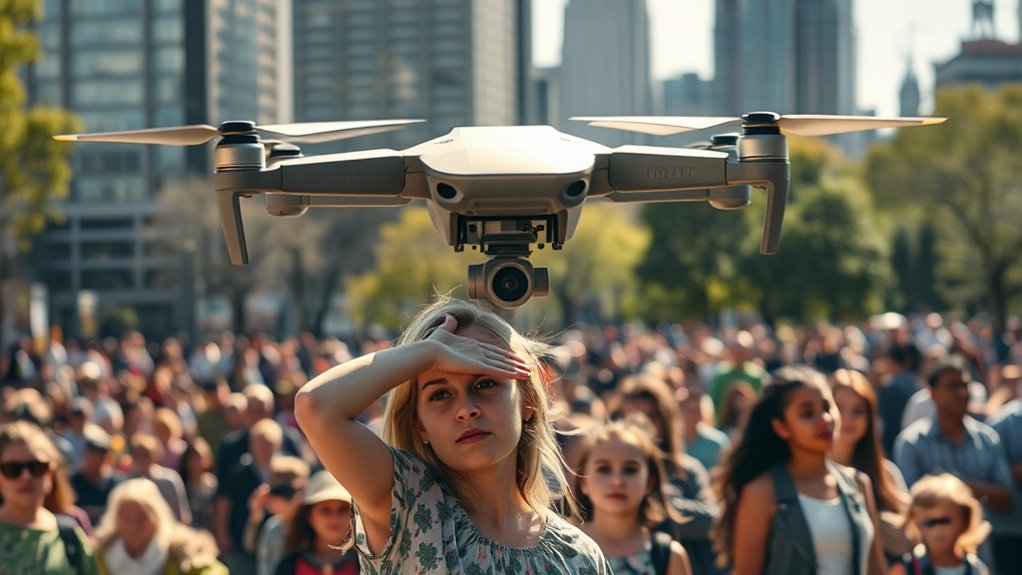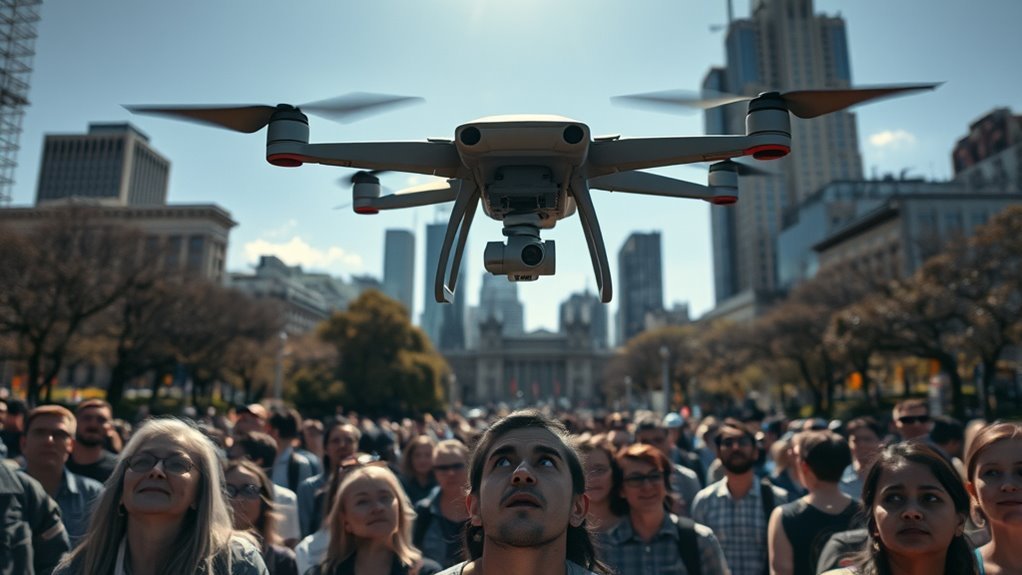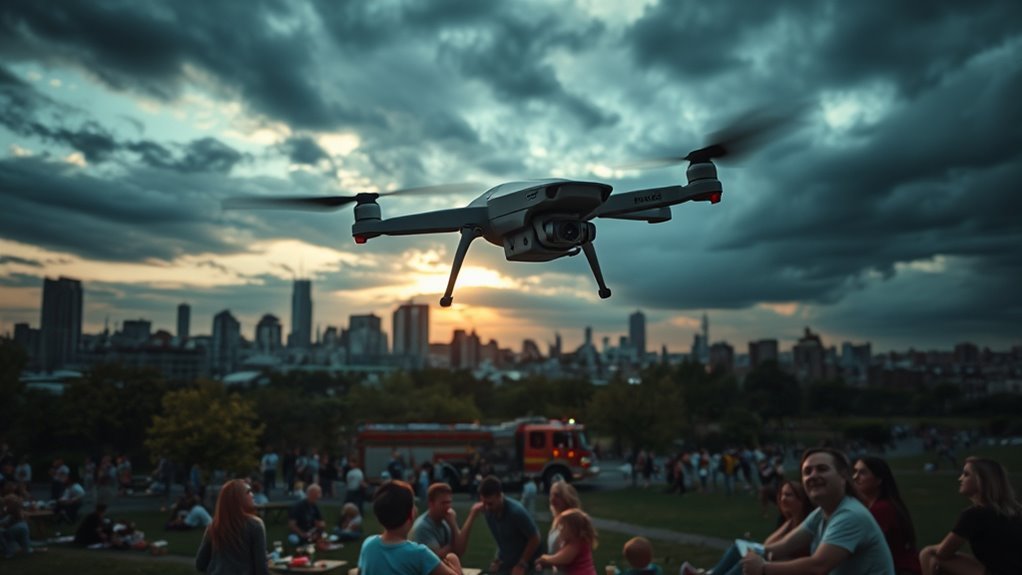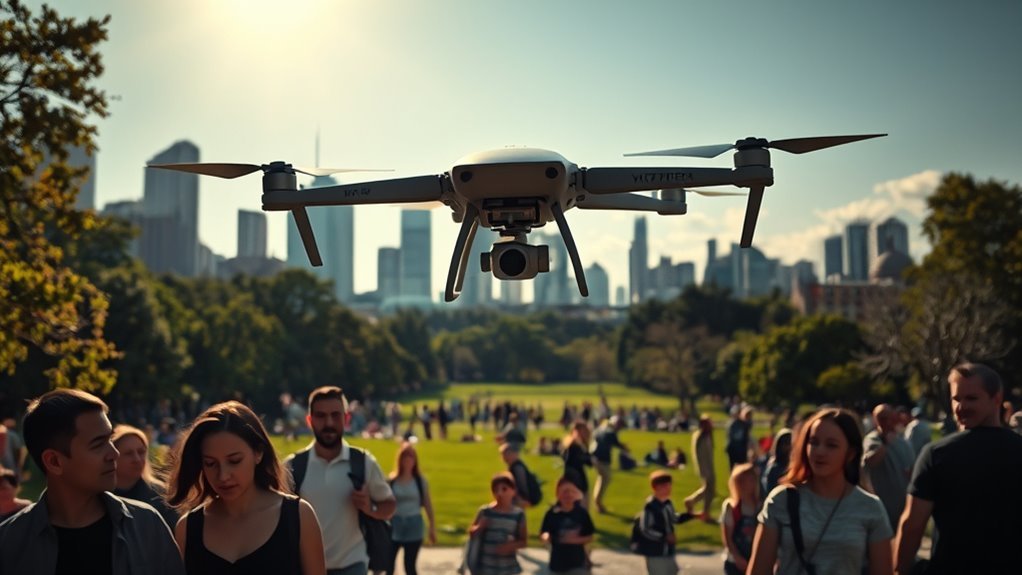Drones can pose dangers to public safety despite their benefits. Risks include mid-air collisions with manned aircraft, privacy invasions, and potential accidents causing property damage or injuries. Inexperienced pilots and lack of awareness contribute to these hazards. Effective regulation and oversight are critical to mitigating these risks and ensuring safe operations. Understanding these complexities can help you navigate the implications of drone technology more effectively, and there’s much more to discover on this topic.
The Rise of Drone Technology

As drone technology has rapidly evolved, its applications have expanded into various sectors, greatly impacting public safety. You’ll notice drone innovation is reshaping how first responders operate, enhancing efficiency in emergency situations. Aerial applications, such as search and rescue missions or real-time surveillance, are now commonplace. This evolution empowers agencies to gather essential data quickly, often in environments that are challenging or hazardous for humans. Additionally, drones are being utilized for monitoring traffic patterns and evaluating disaster areas, providing vital insights that enhance community safety. The ability to deploy drones effectively can mitigate risks and optimize resource allocation, ensuring that safety measures are both proactive and responsive. With such potential, embracing this technology could redefine public safety paradigms. Moreover, drones are crucial for real-time aerial surveillance that supports rapid hazard identification and enhances situational awareness in emergencies. Furthermore, the incorporation of advanced surveillance systems allows for precise threat detection, significantly improving response strategies in crisis situations.
Common Risks Associated With Drone Usage

When using drones, you should be aware of several common risks that can arise. Airspace collision hazards pose a significant threat to both manned aircraft and other drones, while privacy invasion concerns can lead to legal and ethical dilemmas. Additionally, uncontrolled flight risks can result in accidents or property damage, underscoring the need for responsible usage. Moreover, awareness of drone surveillance mechanisms can help mitigate privacy threats and promote responsible drone operation. Understanding the limitations of drones in terms of signal penetration and environmental factors is crucial to ensure safe and effective usage.
Airspace Collision Hazards
Although drones offer innovative solutions for various applications, they also introduce significant airspace collision hazards that must be carefully managed. As drone usage increases, the risk of mid-air collisions with manned aircraft poses a serious threat to public safety. Implementing effective collision prevention strategies is essential.
| Collision Risks | Mitigation Strategies |
|---|---|
| Inexperienced Pilots | Training and Certification |
| Lack of Awareness | Public Awareness Campaigns |
| Airspace Congestion | Advanced Airspace Management Systems |
Privacy Invasion Concerns
The increasing prevalence of drones in various sectors raises significant concerns regarding privacy invasion. You might not realize how easily your data security can be compromised through public surveillance. Here are three key issues to ponder:
- Intrusive Monitoring: Drones can capture footage and data without your knowledge, leading to unauthorized surveillance of your daily activities.
- Data Misuse: Collected information may be stored or shared with third parties, potentially exposing sensitive personal details.
- Lack of Regulation: With minimal oversight, drone operators might exploit their capabilities, jeopardizing your right to privacy.
As drones become more common, it’s essential to address these privacy concerns to protect individual freedoms and guarantee data security in our increasingly monitored world.
Uncontrolled Flight Risks
While drones offer remarkable advantages in various fields, the potential for uncontrolled flight poses serious risks that can impact public safety. Uncontrolled drones can result from flight anomalies like software glitches or pilot error, leading to emergencies that require swift reactions. These incidents often necessitate emergency landings in populated areas, which can create chaos and danger. Furthermore, aerial maneuvering becomes a challenge when drones venture into no fly zones, further complicating safety efforts.
| Risk Factor | Description | Mitigation Strategy |
|---|---|---|
| Uncontrolled Drone | Loss of control over drone | Implement safety protocols |
| Flight Anomalies | Unexpected behavior during flight | Regular software checks |
| Emergency Landings | Forced landing in unsafe areas | Designate safe landing zones |
| Aerial Navigation | Difficulty in maneuvering airspace | Use advanced navigation tools |
| Pilot Error | Mistakes made by the operator | Training and certification |
Incidents and Accidents: Real-World Examples

As drones become increasingly integrated into various sectors, incidents and accidents involving these aerial devices have raised significant concerns about public safety. You might be surprised to learn that drone accidents can occur even with existing safety regulations. Here are three notable examples:
- Near Misses with Aircraft: Drones have interfered with commercial flights, leading to potentially catastrophic near misses.
- Property Damage: In urban areas, drones have crashed into buildings or vehicles, causing damage and raising liability concerns.
- Injury Incidents: Accidents involving drones have resulted in injuries to bystanders, highlighting the risks associated with recreational use.
These examples underscore the urgent need for stricter enforcement of safety regulations to protect both the public and drone operators.
Privacy Concerns and Surveillance Issues
As drone technology advances, you may find yourself questioning the balance between safety and privacy. These devices can easily invade personal space, raising concerns about who’s watching and how the data is used. Understanding the legal and ethical implications of drone surveillance is essential in maneuvering this complex landscape. Additionally, NDAA compliance necessitates a thorough assessment of drone supply chains to ensure that privacy standards align with security regulations. Moreover, advanced sensor technology is critical in enhancing the safety and efficiency of drone operations, helping to mitigate privacy risks through responsible flight management.
Surveillance Technology Advancements
With the rapid advancements in drone technology, concerns about privacy and surveillance have become increasingly significant. As drone monitoring evolves, you might find yourself questioning the implications of enhanced surveillance capabilities. Here are three key points to reflect on:
- Data Collection: Drones can capture vast amounts of data, potentially infringing on personal privacy.
- Proliferation of Use: As more entities adopt drones, the potential for misuse in surveillance increases, creating a chilling effect on freedom.
- Regulatory Gaps: Current laws may not adequately address the implications of drone surveillance, leaving you vulnerable to invasive monitoring.
As you weigh the benefits of drone technology against these privacy concerns, it’s essential to advocate for responsible use that respects individual freedoms while ensuring public safety.
Invasion of Personal Space
While the potential benefits of drone technology are undeniable, the invasion of personal space through surveillance raises significant privacy concerns. You might feel uneasy knowing that drones can easily breach personal boundaries, capturing images and data without consent. This intrusion can lead to social discomfort, as people become increasingly aware of being monitored in their daily lives. The pervasive nature of drone surveillance may foster an atmosphere of distrust, where individuals question their freedom to engage in ordinary activities without being watched. As society embraces technological advancements, it’s important to address these privacy issues, ensuring that the use of drones respects personal space and promotes a sense of security rather than anxiety. Balancing innovation with individual rights is essential for a free society.
Legal and Ethical Implications
The concerns surrounding drones extend beyond mere invasion of personal space to encompass a complex web of legal and ethical implications. As you consider the rise of drones, it’s essential to navigate the legal frameworks that govern their use and the ethical considerations that arise.
- Privacy Rights: Drones can infringe on your right to privacy by capturing images or data without consent.
- Regulatory Compliance: Understanding existing regulations helps guarantee that drone operators respect public safety and privacy.
- Surveillance Ethics: The potential for abuse in surveillance raises questions about the moral responsibilities of drone users.
These factors necessitate a careful balance between technological advancement and the preservation of individual freedoms. You deserve to feel safe and respected in your own space.
Regulatory Measures and Safety Standards
As drone technology rapidly evolves, understanding the regulatory measures and safety standards governing their use becomes essential for both operators and the public. Regulatory frameworks are in place to guarantee safety certifications are met, promoting responsible operation while allowing for innovation. Furthermore, compliance with drone registration requirements ensures that operators are accountable and drones are tracked effectively.
| Measure | Description | Importance |
|---|---|---|
| Registration | Mandatory for commercial drones | Enhances accountability |
| Airspace Management | Controlled through regulations | Prevents collisions |
| Training Requirements | Operators must be certified | Guarantees skilled operation |
| Operational Limits | Restrictions on flight paths | Protects public safety |
| Incident Reporting | Required for accidents | Improves future regulations |
These measures aim to balance freedom in drone use with the necessity of public safety, fostering a safer environment for all. Additionally, advanced algorithms for payload management enhance the safety and stability of drones during operation, further supporting regulatory efforts.
Public Perception and Acceptance of Drones
Regulatory measures and safety standards play a significant role in shaping how the public perceives and accepts drone technology. Building public trust isn’t just about regulations; it’s also about how well the community engages with these technologies. Here are three key factors influencing acceptance:
Regulatory measures and community engagement are crucial for building public trust in drone technology.
- Transparency: Clear communication about drone operations fosters a sense of security and understanding. Additionally, proactive vulnerability identification ensures that potential risks associated with drone technology are addressed before they escalate, further enhancing public confidence.
- Community Involvement: Engaging local residents in discussions about drone use can alleviate fears and misconceptions.
- Demonstrated Safety: Showcasing safety protocols and successful drone operations can help build confidence. Furthermore, the integration of AI and autonomous systems in drone technology enhances operational efficiency, further reassuring the public about safety measures. When the public feels informed and involved, acceptance of drones can grow, paving the way for innovative applications that enhance freedom while prioritizing safety.
Future Prospects for Safe Drone Operation
While advancements in drone technology continue to evolve, ensuring safe operations remains a critical priority for stakeholders. The future of safe drone operation hinges on integrating automated systems and enhancing drone education. By focusing on these areas, we can foster responsible usage and mitigate risks. AI-enhanced obstacle avoidance features will play a significant role in improving flight safety. Furthermore, understanding federal laws governing drone operation will be essential in shaping future regulatory frameworks.
| Aspect | Future Implications |
|---|---|
| Automated Systems | Increased collision avoidance |
| Regulatory Compliance | Streamlined airspace management |
| Drone Education | Informed operators and users |
| Public Awareness | Improved community acceptance |
As you consider the future of drone operations, keep in mind that a collaborative approach to safety, education, and technology will empower individuals while safeguarding public interests. Emphasizing these components can pave the way for a harmonious coexistence with drones in our everyday lives.
Frequently Asked Questions
Can Drones Interfere With Manned Aircraft Operations?
Drones can indeed interfere with manned aircraft operations if drone regulations aren’t enforced. Effective airspace management is essential to prevent collisions, ensuring both recreational drone use and manned flights operate safely within shared airspace.
What Are the Environmental Impacts of Drone Usage?
They say, “What goes up must come down.” Drone usage can lead to environmental concerns like drone waste accumulating in ecosystems and noise pollution disrupting wildlife. Evaluating these impacts is essential for sustainable aerial technology development.
Are There Specific Drone Types More Prone to Accidents?
When considering drone types, mini drones often have stability issues, while racing drones, built for speed, can lead to accidents due to their agility. Understanding these characteristics helps you assess potential risks effectively.
How Do Drones Affect Wildlife and Natural Habitats?
Drones can considerably affect wildlife and disrupt habitats. Their noise and presence may cause stress to animals, leading to changes in behavior or displacement. It’s essential to contemplate these impacts when utilizing drones in natural areas.
What Insurance Is Available for Drone Operators?
Steering through the skies without protection’s like sailing a ship without a lifeboat. For drone operators, liability coverage is essential. Explore various policy options to safeguard your freedom while flying high and minimizing risks.

